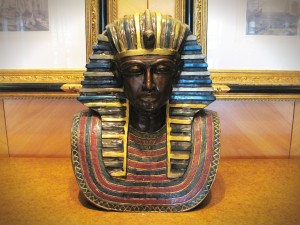 Who Was King Tut?
Who Was King Tut?
On Jan. 2, 2013, I went with a friend and her daughters to the King Tut Exhibit in Seattle. King Tutankhamun–King Tut to most of us–was an Egyptian king made famous by his tomb of hidden treasures found in the early 1900’s. Often referred to as the “boy-king,” Tut reigned from (approx.) 1336-1327 BCE and is thought to have died by the time he was nineteen years old.
Did King Tut Reign Before Moses Or After?
The NIV Study Bible charts, maps, and notes are my “go-to” reference guides for everyday Bible study. Since Deep-O-Tionals is currently delving into Exodus, I wanted to know if King Tut’s culture was pre- or post- Moses and the exodus.
My NIV Study Bible chart: 1446 BCE–The exodus, Red Sea crossing. (Notice, this is from a chart, not Scripture itself.)
According to NIV scholars, King Tutankhamun reigned after Moses and the exodus, meaning the wealth in King Tut’s tomb would have been rebuilt after the plagues of Exodus 7-11. Remember the plagues? Egypt was nearly destroyed by frogs, gnats, boils, hail, locusts, etc.
So then I went to the exhibit…
We were given these stylish little self-guided audio devices, and my supercalifragilisticexpialidocious-techy brain figured out how to use it 2/3 through the exhibit. As I listened to Harrison Ford’s smooth tone explain each numbered artifact, I heard a troubling fact from King Tut’s curators:
“Ramesses II was Pharaoh of the biblical Exodus, reigning from 1279-1213 BCE.”
Ugh. There seemed to be a “slight” discrepancy in the educated guesses of King Tut’s curators and my NIV pals…about 200 years of discrepancy! According to Harrison Ford and the Egyptologists, King Tut reigned before the NIV scholar’s dating of Moses and the exodus.
So Who’s Right–NIV Chart or Egyptologists?
Well, Hollywood sides with the Egyptologists. Cecil B. Demille’s movie, The Ten Commandments, said Moses dealt with Rameses. Disney’s animated flick, The Prince of Egypt, also depicts Rameses as the Pharaoh at odds with the Moses of Scripture.
So did the NIV Bible scholars make a 200-year mistake? (Don’t they go to the movies?)
Scripture Doesn’t Name Moses’ Pharaoh…
If Scripture gave the specific name of Egypt’s king during Moses’ ministry, I wouldn’t be writing this blog post. SCRIPTURE ALWAYS WINS! But the scholars who researched and wrote the NIV Study notes are as fallible as the Egyptologists that prepared the tour notes for King Tut’s exhibit.
The Truth Is…No One Knows For Sure
Egyptologists are brilliant people. NIV scholars are brilliant people. Who’s right? Who knows. Finding a discrepancy in research doesn’t rock my world. It’s actually common to find differing opinions as I dig into biblical stories.
The Value of King Tut’s Tomb
So what can we KNOW about King Tut, and how can it help us today? Here’s what I know after seeing the artifacts from a young king’s tomb that have been preserved for over 3,000 years:
- The wealth of King Tut’s Egypt was staggering.
- Egypt’s cultural and technical advancements were beyond my imagination.
- Though the Bible is not a comprehensive record of the ancient lands surrounding Israel, the information it does include about Israel’s neighbors is as accurate as its record of Israel itself.
Scholars will always contradict scholars, but nothing in King Tut’s tomb proved (or even suggested) a discrepancy in Scripture.
Today’s Question:
Do YOU have questions about what I might have seen at King Tut’s exhibit? (We weren’t allowed to take pix, or I would post them! The pic above was from a free stock photo website, a King Tut bust from a hotel lobby decoration!)
I’ll post two more weeks of insights that have been stirring my heart after visiting the ancient Egyptian exhibit…be sure to check back next week! 😉


